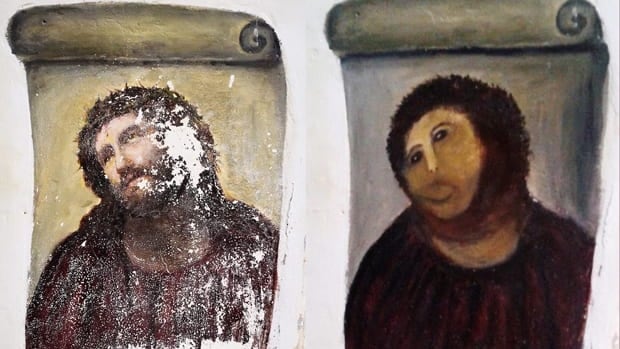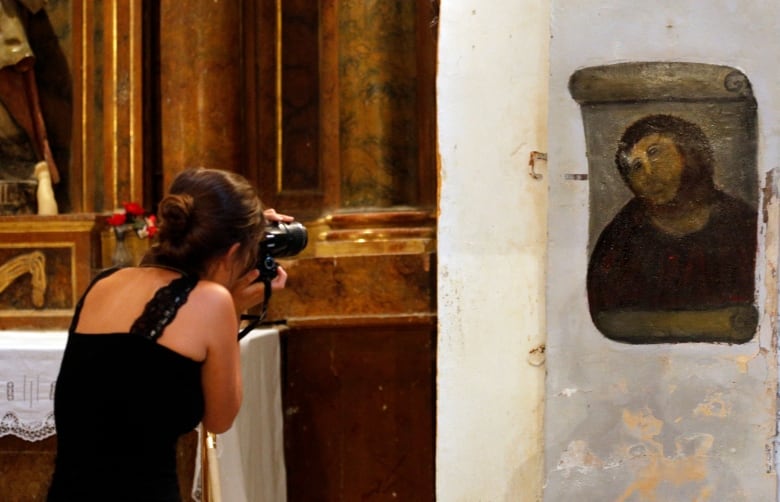
As It Happens5:26Remember this botched Spanish fresco? An opera about it just hit the stage in Vegas
The first time Andrew Flack saw Cecilia Giménez’s photograph in the newspaper, he felt a wave of empathy for the well-meaning woman who had inadvertently become an international punchline.
When the Sanctuary of Mercy church in Borja, Spain, discovered their 19th-century fresco of Jesus had been painted over in 2012, they suspected vandalism. But it turned out to be the handiwork of one of their own parishioners.
Giménez, then 81, had taken it upon herself to restore the fading fresco as a labour of love. But she was not a professional artist, and her unfinished work transformed Jesus in his crown of thorns into a kind of flat-faced monkey man.
“When I saw her photograph, she was in anguish and I could tell she wasn’t a villain,” Flack, a public relations expert-turned-playwright, told As It Happens host Nil Köksal. “My heart went out to her.”
Flack reached out to his friend, Paul Fowler, a composer, and the pair set to work telling Giménez’s story for the stage. Eleven years later, the comic opera Behold the Man made its international premiere in Las Vegas to a sold-out theatre on Saturday.
“It was a sensation,” Flack said.
WATCH | Trailer for the comic opera, Behold the Man:
As Flack and Fowler penned the opera in Colorado, the story of the botched fresco was still unfolding in Spain. All the while, they kept in touch with Giménez, getting the inside scoop in real time.
“We’ve been to Spain five times to be with these folks and they’re just so lovely. And they trusted us from pretty much Day 1, which is just so remarkable,” Flack said.
Giménez, now almost 93, lives in a retirement home where she is being treated for dementia. Her niece, Marisa Ibáñez, was on hand for the Saturday premiere at the Opera Las Vegas at the College of Southern Nevada.
Pilgrimages to the Christ Monkey
Giménez, Flack says, hadn’t finished her restoration when it went viral. Halfway through her attempt, she went on vacation — and returned to find herself at the centre of an international firestorm.
The story made headlines around the world. Late night hosts were cracking jokes about it. People online had nicknamed the restoration “Christ Monkey,” “Beast Jesus” and “Potato Jesus,” among others.
“If you’re ever started a painting and you’re not finished, don’t go on vacation,” Flack warned.

The years that followed were a roller-coaster for Giménez, Flack said. At first, she was the target of widespread scorn and mockery — both from strangers around the world, and from her own neighbours.
But her mistake soon turned out to be the town’s blessing.
Giménez’s well-meaning restoration reached a far greater audience than the original piece, Elías García Martínez’s Behold The Man, ever had. Suddenly, thousands of tourists were descending on the remote Spanish town during a global recession.
“People went on pilgrimages to see this,” Flack said.
Over time, the church, the city and the community got behind it. In 2016, the city unveiled an interpretation centre devoted to the piece, with Giménez as a guest of honour.

Unlike the original piece, the infamous restoration is kept on display behind Plexiglass “like they might do with the Mona Lisa,” Flack said.
Giménez receives a cut of the profits from the art centre and merchandising, which helps fund the retirement home where she now lives — something she and her lawyer had to fight for.
It’s a story that is equal parts ridiculous and sublime, Flack says.
“The things that actually transpired in the story are ridiculous,” he said. “But Cecilia … had a sublime response to it, really. And it was her faith and it was her belief that she would come through this and that God would help her come through it.
“She’s made this mistake and she feels maybe like she’s been abandoned. But it turns out so well. At the end, everyone else realizes it’s a kind of miracle that the resulting tourism brought all this financial interest back to the town.”
‘A happy ending’
CBC was unable to reach Giménez’s family for comment. But her niece, Ibáñez, told the Guardian newspaper that while her aunt went through an “awful time” in the aftermath of the restoration, she’s not suffering any longer.
“The only good thing about the dementia is that she only remembers the good part of what happened,” she said. “She doesn’t remember the bad bits at all and she’s turned it into a beautiful story.”
While the Vegas run of Behold the Man wrapped up Sunday, Flack is confident this won’t be the last the world sees of his play about faith, forgiveness and silver linings.
“How many times in our lives do we have something really bad happen, but it turns out good? And it wouldn’t have happened that way if the bad thing hadn’t happened in the first place,” he said. “It’s really a happy ending.”